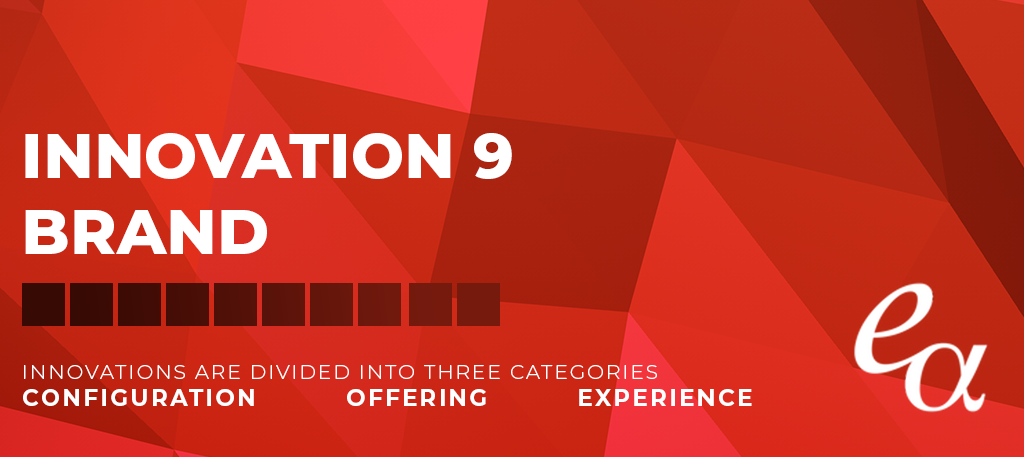Intro
In this series of posts, we will be inspecting Doblin’s 10 Types of Innovation, a popular framework for analyzing innovations in business developed by the Doblin Innovation Firm in Chicago. Innovations are divided into three categories: configuration, offering, and experience. Configuration focuses on the innermost workings of an enterprise and its business system, offering focuses on an enterprise’s core product or service, and experience focuses on customer-facing elements. In this post, we will analyze the third block in experience, brand innovation.
Definition
Brand Innovation is essentially about how you represent your offerings and business. Doblin defines brand innovation as:
“Brand innovations help to ensure that customers and users recognize, remember, and prefer your offerings to those of competitors or substitutes. Great ones distill a “promise” that attracts buyers and conveys a distinct identity. They are typically the result of carefully crafted strategies that are implemented across many touchpoints between your company and your customers, including communications, advertising, service interactions, channel environments, and employee and business partner conduct. Brand innovations can transform commodities into prized products, and confer meaning, intent, and value to your offerings and your enterprise.”
Brands shouldn’t be thought of as something “static” or reductive like a logo, but rather as a living, breathing persona that builds character, associations, and friends over time. Brand innovation isn’t as simple as a single successful campaign or marketing strategy or the creation of a new brand — it revolves around designing and expressing a brand in a way that is distinct from your competitors but still relevant to your customers. Brand innovations will always improve the perception and reputation of a company’s offering.
Examples
Brand innovations can span a wide gamut of possibilities. Some common types include:
- Value Alignment – expressing a company’s big idea or set of values transparently and consistently and aligning it with a company’s brand identity
- Extensions – offering a new product or service under the umbrella of an existing brand
- Component Branding – elevating the overall value of new products by using branded components
- Private Label – establishing your brand for goods manufactured by others
- Certification – creating a unique designation named after a brand that can be applied to other’s offerings
For this blog post, we will focus on examples regarding value alignment, extensions, component branding, and private labels.
Value Alignment Examples
These brand innovations align a company’s values with their brand identity.
Microsoft is an American multinational technology company that develops, manufactures, licenses, and sells computer software, consumer electronics, personal computers, and related services. Though Microsoft is a technology company, their blog Microsoft Stories focuses on human stories — using the power of storytelling to make its content compelling. Human stories have a way of connecting people in powerful ways and create warm and fuzzy feelings for a brand, and by placing their emphasis on them, Microsoft communicates to consumers that people are what they value.
The Walt Disney Company is an American diversified multinational mass media and entertainment conglomerate. Disney places a great deal of emphasis on the intangible quality of “magic,” which is saturated through all of their offerings, from theme parks to movies. Though this rigidity in expectation may limit the company creatively (for instance, no other major film studio limits themselves to a “feeling”), the power of Disney’s brand ensures a large and consistent audience for each of their new offerings.
Nike is an American multinational corporation that designs and manufactures footwear, apparel, equipment, accessories, and services. After NFL quarterback Colin Kaepernick rose to prominence for protesting police brutality and racial inequality, Nike began a campaign that made Kaepernick the face and voice of their brand. By aligning their brand with such a controversial figure, Nike showed a willingness to lose customers in order to stand by their progressive social and political values.
Extension Examples
These brand innovations successfully leveraged new products and offerings through an existing brand.
Virgin Group is a British multinational venture capital conglomerate founded by Sir Richard Branson. Though it started as a mail order record business, it has since expanded into planes, trains, rockets, telecom, wealth, health management and more, all under the Virgin brand name. Due to its near-ubiquitous presence, consumers have grown to understand Virgin’s brand, which is to be different and fun while spicing up the industries into which it ventures.
Amazon is an American multinational technology company that focuses on e-commerce, cloud computing, digital streaming, and artificial intelligence. While Amazon started as an online bookstore, it quickly expanded its offerings to include similar products like CDs and DVDs, and today has extended its brand to cover e-books, cloud services, film and TV streaming, and smart home devices, among others. While Virgin may be an example of a brand extending itself to cover more traditional businesses, Amazon shows that in the 21st century, expanding the breadth of digital services alone can be just as effective, if not more.
Apple is an American multinational technology company that designs and sells consumer electronics, computer software, and online services. For most of its history, Apple dealt almost exclusively within the space of personal computers and their accessories, until it introduced the iPod in 2001. This expansion into MP3s and the music market greatly increased Apple’s popularity and would mark the first of many successful brand extensions that were to come.
Private Label Examples
These innovation types have to do with goods manufactured by one company for sale under another company’s brand.
Trader Joe’s is an American chain of grocery stores with over 500 stores nationwide. While most grocery stores rely on the power of individual product brands, Trader Joe’s takes the opposite approach by having nearly 85% of its products be under the “Trader Joe’s” private label brand name. By seeking out unique, seasonal, and quality products and sourcing directly from individual suppliers, Trader Joe’s has built a reputation for offering varied, seasonal items that appeal to customers’ desires to purchase local.
Costco Wholesale Corporation is an American multinational corporation that operates a chain of membership-only big-box retail stores. Accounting for more than a third of all Costco sales, Kirkland Signature is Costco’s private label that sources many of their products from the same manufacturers as their respective name brands — for instance, some Kirkland-brand coffee is roasted by Starbucks. While private labeling in grocery retail is nothing new, Costco’s use of private labeling in conjunction with their business strategy of selling products at wholesale scale has given their private label a unique advantage in the market.
Component Branding Examples
These brand innovations upgrade the overall value of a product by utilizing branded components that make customers aware of their value while building preference and bargaining power.
Intel is an American corporation and technology company that is the world’s largest manufacturer of semiconductors. While company names within the computer component market were traditionally only known to hobbyists and enthusiasts, Intel managed to become a household name through its “Intel Inside” campaign. Despite Intel not building computers themselves and merely providing computer manufacturers with semiconductors, just having an “Intel Inside” sticker on a box made those computers more valuable.
Gore-Tex is a waterproof, breathable fabric manufactured by W.L. Gore & Associates that can repel liquid water while allowing water vapor to pass through. Gore-Tex has a variety of applications but is mostly used for lightweight, waterproof clothing for all-weather use. The successful branding of Gore-Tex has led it to become synonymous with high-performance fabric, and products that utilize Gore-Tex often mention it prominently in order to take advantage of consumer’s trust in the Gore-Tex brand.
Techniques to Develop Brand Innovation
Any strong brand strategy must take into consideration a company’s values, position, benefits, and many other elements. Because brands are so inherently intangible, tactics for brand innovation can be virtually anything. A brand may enjoy a boost simply as a byproduct of any other positive innovation. For instance, in the sustainability space, it’s virtually impossible to separate a brand from its sustainability efforts. Though brands are oftentimes so closely intertwined with a company’s performance, offerings, and other business-related aspects, there are ways to develop and home in on brand innovations that can help companies better focus on how to communicate their brand to their customers.
Companies can start by identifying the intent of their brand or an initiative and gaining a deep understanding of their target audience. Who is this for? What do customers think of your brand? What do non-customers think of your brand? What do you wish they would understand about your brand? Then, explore opportunities and gaps that exist in the market, ideally in conjunction with other business units like product development. How does the brand fit within the overall strategy of the firm? Is there any cognitive dissonance people could feel while looking at your brand?
At this point, firms must get creative. How can a firm articulate the brand in a new and exciting way? How can it reinforce a brand in the mind of consumers? Is there a way to align corporate values to the brand that hadn’t been thought of before? How are your competitors communicating their brand? What are they doing right, and what are they doing wrong? Once a firm has developed their brand innovation, it must then plan the implementation. What resources and operations are necessary? Which departments should coordinate? What is the final timeline? Ultimately, companies must develop their brands to encapsulate compelling and creative ideas that engage and inspire consumers.
Impact
A strong brand can sustain a company for years and years, and can even stick around in public consciousness even after the company behind it is gone or bankrupt. Compelling brands have the power to build positive karma over time and attract people who share their interests or admire aspects of it. There’s a certain pride that can come with a brand identity, which can be seen through the people who you proudly choose to associate with. While it builds empathy between a consumer and offering, at the same time, it gives companies a better competency position in the market. A powerful brand innovation can have far-reaching effects on a company, giving it the ability to attract new customers, position it in the minds of the general public, and lead to long-term profitability.
Brand innovations can also have significant effects on the internal workings of a company as well. Brand innovations nurture new ideas, encourage creativity, and help promote cross-department collaboration. By unifying departments and employees behind a unifying set of ideas and values, companies can become more efficient and enjoy the benefits of employees who are more emotionally invested in the success of the company. Brand innovations can completely reshape corporate culture and attract top talent, reinforcing a positive feedback loop.
Conclusion
Brand innovations can transform commodities into prized products and imbue your company and offerings with meaning, intent, and value. When done right, brand innovations can be a strategic differentiator that separates you from your competitors. With the right branding innovation, you can not only ground your company properly in the mind of the public, but also test those limits and expand into different offerings and operations with the trust you’ve gained from customers. The best brand innovations resonate deeply with customers and build reputations that can stand the test of time.




